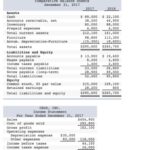Content
The levied amount is sent to IRS, and the balance of the payment is sent to the taxpayer. Whether you’re facing the possibility of a state levy or trying to get one released, you need to have a firm strategy in place. It’s never too late to form a proactive strategy https://kelleysbookkeeping.com/ when facing a tax levy. Working with a tax relief expert is the fastest way to resolving a state or federal tax levy issue. If you’re looking for a comprehensive guide that will answer all of your questions about tax levies then you’re in the right place.
- You may be able to request a levy release before or after the property is levied.
- Every year, each property in the district is valued by a tax assessor, and taxation is allocated on a percentage basis.
- Certain exceptions do exist for the IRS to impose a levy and take action prior to the 30-day period.
- The notice must arrive at least thirty days prior to the levy taking place.
If you have received a notice from the IRS, time is not on your side. You need the right strategy to be successful and get your life back. Negotiating with the IRS requires a specific set of skills and expertise. Working with a tax resolution expert is the best way to ensure all of your options and rights are fully exercised. Like the IRS, the state will notify you of your debt and begin a series of notices. State taxing authorities must follow a strict process of notifications before issuing a tax levy against you.
Tax Levy
Unlike other creditors like your mortgage lender or credit card company, the IRS has the power to take your wages, freeze your bank account, and in the worst cases imprison you. Facing the IRS on your own can be intimidating, and if you’re not prepared and know what you’re doing, can end badly. After the 30 days have passed with no action on your part, the IRS can begin the levy at any time of their choosing. If you owe money to multiple sources like credit card companies, the IRS takes precedent in collecting debts owed. A tax rate is the percentage used to determine how much a property taxpayer will pay. A levy represents the total amount of funds a local unit of government may collect on a tax rate.
In some cases, you may be required to request innocent spouse relief within two years from the date the IRS first attempted to collect the tax from you. However, you may not be able to present these arguments at a CDP hearing if you had an earlier opportunity to make these arguments and failed to do so. If you don’t request your CDP hearing within 30 days, you lose the opportunity to have the Tax Court review your case. You have a much better chance of avoiding a levy before it happens, such as during a Collection Due Process hearing. Garnishments can be stopped or lowered by working out another alternative with the IRS. You may still owe interest and penalties, but formalizing an installment plan with the IRS prevents them from assuming that you simply decided not to pay.
What is a tax levy?
The IRS will usually file a lien against your property after sending you a Final Notice of Intent to Levy (CP504). The IRS can demand of an employer that What Is A Tax Levy? a portion of the wages of a tax debtor be sent directly to the IRS. Section 6334 does allow for an exempt amount that must remain outside of the levy.
- This includes any property you acquire after the IRS puts the lien into effect.
- Here’s how a tax levy can affect you, as well as how to remove one.
- If the individual still neglects or refuses to pay the tax, the IRS will send a Final Notice of Intent to Levy and Notice of Your Right to a Hearing (a levy notice).
- By doing so I waive any registration to any state, federal or corporate Do Not Call registry.
- FMS (now Fiscal Service ) and IRS provided information about the continuous tax levy program to key House and Senate committee staff.
- Fighting the IRS on your own can make you feel lonely and desperate.
- For a full rundown of your appeal rights, consult Publication 1660, Collection Appeal Rights (PDF).
In the second hypothetical scenario, the IRS has levied a person’s bank account after they have fully paid all of their tax liability. The bank charged the taxpayer a $100 fee for processing the levy, and the taxpayer would like to recover the fee for $100 from the IRS. Intangible property and property belonging to the individual that is held by someone else can also be levied. This includes wages, retirement accounts, dividends, bank accounts, licenses, rental income, accounts receivables, commissions, or the cash loan value of a life insurance policy. The Internal Revenue Code (IRC) authorizes levies to collect delinquent tax. Any property or right to property that belongs to the taxpayer or on which there is a Federal tax lien can be levied, unless the IRC exempts the property from levy.
IRS Form 668-W and Levy on Wages
Since a lien is a public document, the credit monitoring agencies may find it and include it in your credit report. You may be prevented from conducting certain financial transactions that would increase your debt. The only way to remove the lien from your credit report is to contact each agency directly to modify or remove it once you get the lien released. The FTB can issue a Notice of Levy to levy money, or the right to money, that is held or controlled by the taxpayer or by a third party.
- The IRS can also apply a failure to deposit penalty up to 15% of the amount of employment taxes not deposited.
- Be aware of what consequences your state government can impose for failing to pay your taxes.
- Some types of levies are used more commonly than others, including bank levies and wage garnishments.
- Let an expert do your taxes for you, start to finish with TurboTax Live Full Service.
If you owe money to the IRS, a levy is a way for the IRS to get their money via ways such as seizing assets. Ideally, you’ll find ways to prevent the tax levy from taking place. Certain third parties are protected from the impact of the secret tax lien.
Get Tax Levy Help
To complete an appeal, contact the IRS immediately to arrange to pay your tax bill and request a tax levy release. If you receive a document titled “Final Notice of Intent to Levy and Notice of Your Right to a Hearing,” a tax levy may be imminent; the IRS could seize the funds or your property in 30 days. At that point, if you aren’t communicating with the IRS already, you should contact them. The IRS issues most levies after it has made several attempts to collect the taxes with a series of notices.
The IRS most likely will not levy assets while they are reviewing an Offer in Compromise application. If you submit the offer after the levy has started, it will not stop the levy. Upon receiving a tax bill, it is your responsibility to take action by paying your owed taxes or looking into other options. If you are unable to pay the full amount, you can set up an installment plan, if you meet the requirements, or submit an offer in compromise. You can also appeal if you do not believe that the amount of tax owed is correct. If you need tax forms for your state, you can get access to all the necessary forms in one place.
The simplest way to avoid a bank account levy is to repay the debt that prompted the levy in the first place, but this is easier said than done. If you can prove that the levy was due to an error on the creditor’s part, or that you were the victim of identity theft, you may be able to have your account access restored. You may also be able to contest the debt or declare bankruptcy, although this will likely require the help of a debt relief attorney.

That is why the amount listed in the NFTL is not a true reflection of your tax liabilities. Common tax levy types include wage garnishment, bank levy, 1099 Levy, reduced tax refunds, property seizure, other asset seizure, and seizure of passports. Depending on a taxpayer’s situation, the IRS will use whichever method is easiest for them to recoup the money that is due.
The tax levy is effective with your very first paycheck after the employer receives the tax levy. Remember, once your funds have been forwarded to the IRS either by the bank or your employer, you are not getting them back. The best way to avoid a tax levy is to file tax returns on time, pay taxes when they are due, and communicate timely with the IRS if you have any questions or disagreements about amounts you may owe. If the IRS decides to levy one of your bank accounts, they start by freezing the funds in that account. They then offer a 21-day waiting period before they seize the cash, during which you have the opportunity to contact and make arrangements with the IRS.

